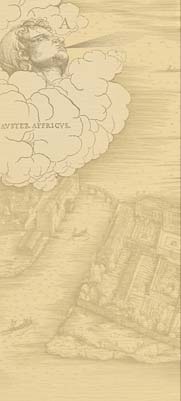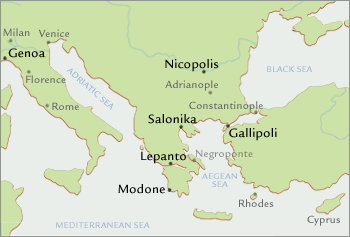Michael's Life: Paron 1414-1420
In 1414, Michael joined the Guard fleet of Venice as a paron for the first time. It was another major step up for the young man from Rhodes. As paron, he would take part in a major sea battle against the Turks in 1416.
Tasks of the paron
At sea, the paron took his orders from the comito, who received his orders from the patron (on a commercial galley) or the sopracomito (on a military galley). In other words, the paron was one of the three senior officers on board. Much of our information on the role of the paron comes from the accounts from pilgrim galleys late in the century, so may not be applicable to what Michael did in this office in the Gulf fleet.
Assuming that the duties of the paron remained constant throughout the century, his crucial work took place before the voyage even began, readying his ship for sea. This task was essential because galleys came from the Venetian Arsenal with little more than masts and anchors. The paron was responsible for provisioning the ship with food and water, for ballasting and stowing, and for ensuring the galley was fully equipped with the literally thousands of pieces of rope and other stores it needed—sail, tackle, weapons.
At sea, the paron oversaw the work of the nochieri and commanded the oarsmen (homo da remo) who sat in the forward part of the ship. He supervised the use of the bow anchors and possibly the operation of the sails. The paron was also supposed to be the first man off the ship whenever it entered a port or harbor, most likely to make sure the ship was properly docked and to make arrangements with locals.
Military voyages
Michael served as paron in the Guard in 1414 and 1415. After his second voyage, he returned home to find his Venetian wife, Dorotea, had died. Because it is likely that their son Teodorino was at least 16 when he accompanied his father on a voyage in 1422, it can be assumed that Michael married Dorotea soon after coming to Venice in 1401. Through his marriage to Dorotea, Michael earned basic rights as a Venetian citizen.
The outstanding military event of Michael's years as paron was his participation in the battle of Gallipoli in 1416, the first major sea battle between Venice and the Ottoman Turks.
Some sort of conflict was almost inevitable. The Venetians were taking over more and more towns and harbors along the coasts of Albania, Greece, and the Greek peninsula (then referred to as the Morea). The Ottomans were simultaneously expanding their interior control over these same areas, having defeated the Hungarians, Serbs, and Greeks.
The conflict started in late 1415, when a fleet of Turkish ships attacked a convoy of Venetian ships in the Aegean returning from the Black Sea. The ships fled to the Venetian-held city of Negroponte, located on the island of Euboea, not far from Athens. The Turks followed, attacking the city in early December, devastating the countryside and carrying off as many as 1,500 Greek prisoners as slaves.
In 1416, the Venetians dispatched an ambassador to the Turkish Sultan Mehmed I to settle the matter. He was escorted to the Turkish port of Gallipoli by a large fleet under the overall command of the captain of the fleet Pietro Loredan.
On May 27, the fleet entered the narrow straits now known as the Dardenelles, which led to Constantinople and the Black Sea. Gallipoli was at the northern end of these straits on the European side. As they approached the city, there was a minor skirmish between the galleys and Turkish troops along the shore. More skirmishes ensued the next day. On the third day, a major sea battle took place.
Michael's ship was in the thick of the fighting. First they boarded and captured a Turkish galleota (a small galley) of 23 benches, then another one of 19 benches. Before long, Michael's ship and two other Venetian galleys were locked in combat with the Turkish flagship. In fierce hand-to-hand combat, the Turkish admiral was killed and his flagship captured.
The battle raged from early morning until 2:00 in the afternoon. When it was over, there were 12 Venetians dead and 340 wounded. Hundreds on the Turkish side died. More than 1,100 were taken prisoner. Among them was Giorgio Calergi, a Cretan who had once led a rebellion against Venice. Loredan ordered the badly wounded Calergi quartered on the poop of his galley. The majority of the other prisoners were skilled, seafaring Christians. Loredan ordered them cut to pieces and hanged as a warning to other Christians who served the Turks. Michael simply noted the "victory over the Turks" in his service record for 1416.
Michael's bravery in the fighting at Gallipoli may have earned him a small honor in 1419, after a year in the commercial fleet. He was given command of a galleota. Normally only nobles commanded warships, but non-nobles like Michael could sometimes command smaller vessels like these. Michael proudly noted the honor, calling himself "patron" in his service record. Michael's entry in the manuscript says he served in the Guard of Albania, suggesting that he was involved in continuing Venetian efforts to gain control of the eastern coast of the Adriatic, particularly to regain control over the town of Drivasto.
Commercial voyages
Michael sailed on two voyages to Flanders in this period. The first took place in 1417, the year after the battle of Gallipoli. On this voyage, Michael sailed as homo de conseio, a remarkable albeit temporary promotion. The homo de conseio acted as a sort of adviser to the patron and to the merchants sailing with the galley.
Michael was still too young to hold such a senior position. He may have received the post as a reward for his bravery in fighting the Turks in 1416. He would not serve as homo de conseio again until 1430.
Michael's second voyage to Flanders in 1420 was less remarkable. Once again, he sailed as paron.












